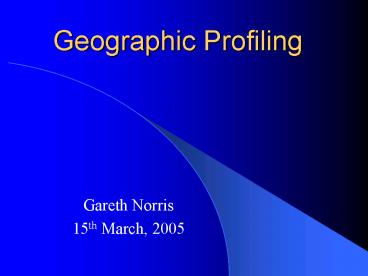Geographic Profiling - PowerPoint PPT Presentation
1 / 23
Title:
Geographic Profiling
Description:
... Canter (1997) 85% of US Serial Killers live within circle. Canter ... Canter & Heritage (1994) Rapists who offend outdoors travel further than those ... – PowerPoint PPT presentation
Number of Views:1227
Avg rating:3.0/5.0
Title: Geographic Profiling
1
Geographic Profiling
- Gareth Norris
- 15th March, 2005
2
Some Important Principles for Understanding
Geographic Behaviour
- Shaw and Mckay (1942)
- The Chicago School
- Zipf (1950) Least Effort Principle
- Brantingham Brantingham (1982) Environmental
Psychology
3
Brantingham Brantingham (1982)
- Spatial knowledge of an area is gained through
everyday activities. - Peoples spatial behaviour is also governed by
familiarity and effort. - Criminal behaviour is therefore expected to
mirror non-offending spatial behaviour. - The places frequented when not offending will
have a bearing on areas used to offend.
4
Pub
Work
Home
Friends
Shopping
Mental Map
5
Peter Sutcliffe The Yorkshire Ripper
- Attacked 21 women in the North of England
- Mostly prostitutes
- Sutcliffe was a lorry driver
- Enquiry lasted for over five years and generated
enormous amounts of information - Had been questioned by the police on a number of
occasions
6
Stuart Kind Centre of Gravity.
Take a map of the area in which the 17 Yorkshire
Ripper offences occurred and mark each location
with a pin. Next take an 18th pin and join it to
each of the 17 locations by a piece of thread.
That location of the 18th pin which minimizes the
amount of thread required is the centre of the 17
offences.
Kind, S.S. (1987). Navigational ideas and the
Yorkshire Ripper Inquiry. Journal of Navigation,
40(3), 385-393. http//www.forensic.demon.co.uk/d-
load.html
7
H
H
8
David Canter the circle theory
- identifying the two crime locations
furthest apart from each other. Using these
locations as the diameter, a circle can be drawn
that includes all the offences. The hypothesis is
that the criminal will be found to live inside
that circle, possibly close to the middle of it.
9
Circle Theory
Criminal Range
Home Range
H
H
Marauder
Commuter
Canter, D. Larkin, P. (1993). The
environmental range of serial rapists. Journal
of Environmental Psychology, 13, pp. 63-69.
10
Accuracy
- Godwin Canter (1997) 85 of US Serial Killers
live within circle - Canter Larkin (1993) 87 of UK Serial Rapists
- Kocsis Irwin (1997) 71 Australian Serial
Rapist 82 Serial Arsonists - Kocsis, Cooksey, Irwin, Allen (2002) 50 of
Australian Serial Rural Burglars
11
Computerized Crime Mapping
- Attempts to emulate theory and predict offender
residence - Rossmo CGT
- MapInfo, Predator, Rigel etc.
- Canter Dragnet
12
Criminal Geographical Targeting (CGT)
- By inverting research that has focused on
relating crime places to offender residences, the
locations of a series of crimes can be used to
determine where an offender might reside. Dr Kim
Rossmo.
Rossmo, K.D. (2000). Geographic Profiling. CRC
Press.
13
Hunting Typologies
- Search Hunter, Poacher, Troller, Trapper
- Attack Raptor, Stalker, Ambusher
- Target Backcloth - opportunity
- Hunting Style affects spatial distribution
14
Jeopardy Surface
- Developed whilst working for Royal Canadian
Mounted Police - Three years experience investigating
interpersonal crimes - Superior level of investigative skill
15
Insertion of crime locations into Dragnet.
Run analysis to produce prioritization map.
16
Prioritization diagram can be transposed onto
street map to determine locations of interest.
17
Computers vs. People
- 21 Students in each group (control
experimental) - Ten crime series five locations for each
- Experimental group given two heuristics
- - majority of offenders homes within circle
defined by two furthest offences - - majority of offenders commit offences close to
home
18
Effect of training on prediction of home
location
Snook, B., Canter, D. Bennell, C. (2002).
Predicting the Home Location of Serial
Offenders A Preliminary Comparison of the
Accuracy of Human Judges with a Geographic
Profiling System. Behavioural Sciences and the
Law, 20, pp. 109-118.
19
Implications
- Indicates that principles involved are effective
(distance decay circle theory) - Uniform improvement not due to intuition or
gut feeling - May be other principles that need to be
identified, i.e. commuters - Casts doubt on utility of computerized systems
and specialized training
20
Future Directions Incorporating Temporal
Information
- Godwin Canter (1997) Dump sites tend to be
at a further distance than points of first
encounter - Canter Heritage (1994) Rapists who offend
outdoors travel further than those who attack
indoors - Davies Dale (1995) Older offenders travel
further - Pettiway (1982) White offenders travel further
than black - Le Beau (1993) Industrial vs. Residential
areas - Rhodes and Conly (1981) Crime type
21
Problems and Limitations
- Doesnt give an address provides areas of
priority - Relies on accurate data and correct linking
- Size and demographics of area
- Not applicable to all crimes
22
(No Transcript)
23
References
- Kind, S.S. (1987). Navigational ideas and the
Yorkshire Ripper Inquiry. Journal of Navigation,
40(3), 385-393. - http//www.forensic.demon.co.uk/d-load.html
- Rossmo, K.D. (2000). Geographical Profiling.
Florida CRC. - Canter, D. Larkin, P. (1993). The
environmental range of serial rapists. Journal
of Environmental Psychology, 13, pp. 63-69. - Brantingham, P.L. Brantingham, P.J. (1982).
Mobility, notoriety, and crime A study of crime
patterns in urban nodal points. Journal of
Environmental Criminology, 11, 89-99.

